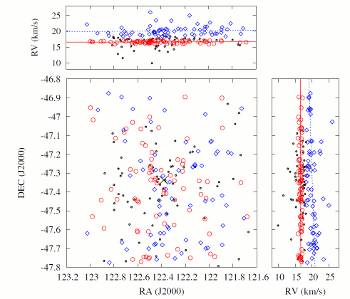The Gaia-ESO Survey: Kinematic structure in the Gamma Velorum cluster (Jeffries et al.)
- Details
- Published on 10 March 2014
Vol. 563
In section 5. Galactic structure, stellar clusters and populations
The Gaia-ESO Survey: Kinematic structure in the Gamma Velorum cluster
 The Gamma Velorum cluster includes a massive young Wolf-Rayet binary system (γ^2 Vel), and it has been one of the first targets of the GAIA-ESO survey. The aim of this study has been to measure the kinematic properties of the low-mass stars as a means to probe the dynamical history of the cluster and to consider how these low-mass stars may populate the surrounding field as they become unbound. Intermediate-resolution VLT/FLAMES spectra were taken for 1242 unique targets around the Li I 6708 Angstrom line, and they were used to derive precise velocities, cluster membership probabilities, and the ages of each star. The authors found that the Gamma Velorum cluster consists of two kinematic components, one of which covers a narrow velocity range, and the other that is broader, 1-2 Myr younger, and slightly offset in velocity. The authors interpret these results as showing that one component is a bound remnant of the original dense cluster that formed the Wolf-Rayet binary (γ^2 Vel) system, and the other is a dispersed population from the wider stellar association. The apparent youth of γ^2 Vel (~3-4 Myr old) compared to the older (≥ 10 Myr) low-mass population surrounding it suggests that the massive binary system formed in a clustered environment after the formation of the bulk of the low-mass stars. It is possible that the formation of the massive binary system terminated star formation in the cluster by expelling all the gas.
The Gamma Velorum cluster includes a massive young Wolf-Rayet binary system (γ^2 Vel), and it has been one of the first targets of the GAIA-ESO survey. The aim of this study has been to measure the kinematic properties of the low-mass stars as a means to probe the dynamical history of the cluster and to consider how these low-mass stars may populate the surrounding field as they become unbound. Intermediate-resolution VLT/FLAMES spectra were taken for 1242 unique targets around the Li I 6708 Angstrom line, and they were used to derive precise velocities, cluster membership probabilities, and the ages of each star. The authors found that the Gamma Velorum cluster consists of two kinematic components, one of which covers a narrow velocity range, and the other that is broader, 1-2 Myr younger, and slightly offset in velocity. The authors interpret these results as showing that one component is a bound remnant of the original dense cluster that formed the Wolf-Rayet binary (γ^2 Vel) system, and the other is a dispersed population from the wider stellar association. The apparent youth of γ^2 Vel (~3-4 Myr old) compared to the older (≥ 10 Myr) low-mass population surrounding it suggests that the massive binary system formed in a clustered environment after the formation of the bulk of the low-mass stars. It is possible that the formation of the massive binary system terminated star formation in the cluster by expelling all the gas.

